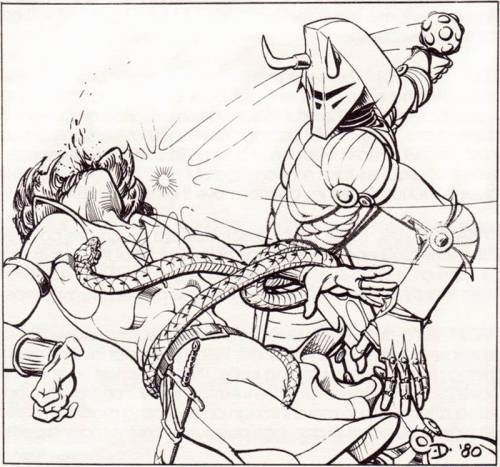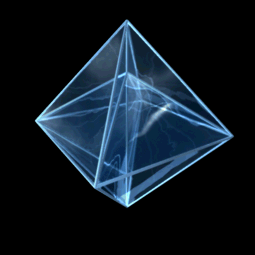1 hour ago
Friday, March 20, 2015
Our Gang
I don't talk a lot about the social aspect of the game here, tending to focus more on ideas or inspirations, but my gaming group has been down a couple of players the past couple of sessions and not just due to difficult schedules (which happens to us sometimes). One of my players--one of my friends, Jim--was diagnosed with colon cancer and has been undergoing chemo. We hope we've worked out a way for him to join us this time via the internet, at least. We'll see.
My present group is pretty new in its current configuration. Andrea is the newest and brings some fresh enthusiasm. Though new to rpgs in general, she has jumped in with both feet. She plays in our group and in a weekly game with another group. Her character is a sort of fussy dwarf cleric, often appalled by the moral failings of the world.
Eric and Bob have gamed with me off and on since we were residents. Bob always plays fighters with a flexible morality and a strong appreciation for gold. In real life, Bob works like crazy and still trains for things like mud-runs and zombie obstacle courses. Eric sometimes tries to play evil or amoral characters, but his inherent goodness always stymies him. He can't even be evil in pretend. He has a fondness for magic-user types.
Tug I know from the comic book store in town where he used to work, but he has since moved on to better things. Tug sort of reminds me of Jake the Dog on Adventure Time! when he's all joie de vivre. He plays a frogling thief named Waylon who strums a banjo.
Gina is a GM in her own right (I've played before in her Boot Hill game) and the author of a Western Romance novel, first serialized on her blog. She's also Jim's wife. When she played a hoodoo woman in our last game,she brought a bag of props with her--including a chickens foot and a crystal ball. This time she's a badass elf ranger--no props, unfortunately.
And Jim, well, it's likely Weird Adventures wouldn't have happened without him, since he did the layout. He writes a comics blog. Despite having a wife who is a gamer, he hadn't really played a lot until I dragged him into it. He's often plays it very cautious and and calculated. He'd do well with a killer DM, but in my games, his over caution just winds up bringing a bit of amusement. As a former local rock star in his youth, it's fitting he plays the bard.
I have to confess, I'm never been a big fan of games, in general. I don't really play video/computer games. Board games are something I like only rarely. I like rpgs, though. In part, it's due to the creativity involved, but without the people I sit at the table with, it would only be writing--and that wouldn't be the same at all.
Thursday, March 19, 2015
Return to Azurth
This weekend the group is getting back together (hopefully the whole gang) for another Land of Azurth session for the first time in a couple of sessions. The PCs will likely invade the partially submerged lair of the Baleful Burly Brothers and their murderous gang.
To get back in the mindset of that world, I updated my Dictionary of Azurth. Check it out for entries on Troglopolis, Apiaria, and Noom.
Wednesday, March 18, 2015
Wednesday Comics: The Multiverse So Far
Too busy tonight for a spotlight on a new world, so I figured it was as good a time as any for a review of what we've covered so far:
Earth-4 (Charlton Earth)
Earth-6 (Stan Lee's Just Imagine Earth)
Earth-10 (Earth X)
Earth-20 (Pulp Earth)
Earth-35 (Awesome Comics Earth)
Earth-37 (Chaykin Earth)
Earth-38 (John Byrne's Generations Earth)
Earth-39 (T.H.U.N.D.E.R. Agents Earth)
Earth-51 (Kirby Earth)
Monday, March 16, 2015
Building Races in 5e
The stats for the races in the 5e PHB always looked like there was a method to their construction. I don't know how strictly in guidelines of that sort were followed, but it certainly looked like the designers had them.
I was a bit disappointed when the DMG came up and didn't really include any guidelines of that sort. Luckily, the internet has come to the rescue with not one but two people claiming to have discovered the formula. Here's one originally posted on Reddit, and another I came across on rpgnet with a pdf and a spreadsheet. I haven't looked at either of them close enough to know how well they match up. They use different numbers, but that doesn't necessarily mean they don't translate.
Sunday, March 15, 2015
Robot Dungeon
I've written before about a world where the dungeoneering was an done by androids who were the remnant of human civilization (all that's here). There's another way to get dungeons crawling with robots, and that's with a future post-apocalyptic world that's been overrun by them. Instead of apes, or fairies, or vampires, let the robots take over something like Screamers (and the Philip K. Dick story it's based on "The Second Variety"), Terminator, or Magnus: Robot-Fighter. Unlike those examples though, human civilization can have been pushed back to pseudo-Medieval levels.
Say the robots have moved mostly underground, leaving humans to limp along on a damaged surface world. The underground bases of the robots would be a lot like dungeons. Robots would have made various robotic or bio-robotic guardians--monsters, of sorts. Maybe the robots are even aliens? A post-sentient, techno-organic swarm that landed and buried itself into the earth, spreading underground like roots, building robotic creatures in a myriad of forms as it went. You'd have a whole underground ecology of robots. Add "magic" (really psionic powers in disguise) and you've got a fantasy world, or close enough.
For a real fantasy world, assume that the alien robotic swarm invaded a fairly D&Dish world (except with maybe less conflict to begin with).
Friday, March 13, 2015
More Entries From the Catalog of Worlds
A follow-up to this post. More excerpts from A Concise Atlas of the Multiverse (2273):
BEDLAM (Pandemonium)
Type: Metaphysical
Reality: Highly Mutable, psychomorphic
Dominant Lifeform: ?
Description: A roiling, colorful manifold filled with psychedelic, pseudo-matter forms spontaneously generated by interaction with the mental imprints of sophont beings, Bedlam is thought to be either a vestige of raw hyperspace prior to manipulation by the Precursors or a walled off area of damaged metric. Its metaphysics have a profound effect on visitors, leading to feelings of depersonalization, paranoia, and sometimes full psychotic reactions among those not properly prepared. Prolong exposure to the naked manifold ultimately leads to dissolution of the physical form, following mental disintegration. Artificial islands of stability exist within Bedlam and these are the primary destinations for visitors. Wildcatters use some islands as bases for attempts to "mine" the metric. Gathziri monasteries are often found in these places, though its unlikely their inhabitants created the islands in the first place.
BLACK IRON PRISON (The Big House)
Type: Metaphysical
Reality: Fixed, paraphysical
Dominant Lifeform: deodands; numerous prisoner species
Description: Black Iron Prison (human designation) is an ancient megastructure, a 4-dimensional hyperoctahedron the size of a dwarf planet, and the pocket universe that houses it. The structure was supposedly constructed by the Precursors as a prison, or maybe as the concept of confinement, itself. It is staffed by a clade of hereditary guards called deodands, who view their job as a quasi-religious obligation. For a fee, they will accept new prisoners from any political body, though very few governments will admit to using their services. No public record of those housed in the Escher-maze cell-blocks of the prison exists, but some of its inmates are likely the descendants of individuals whose accusers have been long forgotten, to say nothing of their alleged crimes.
BEDLAM (Pandemonium)
Type: Metaphysical
Reality: Highly Mutable, psychomorphic
Dominant Lifeform: ?
Description: A roiling, colorful manifold filled with psychedelic, pseudo-matter forms spontaneously generated by interaction with the mental imprints of sophont beings, Bedlam is thought to be either a vestige of raw hyperspace prior to manipulation by the Precursors or a walled off area of damaged metric. Its metaphysics have a profound effect on visitors, leading to feelings of depersonalization, paranoia, and sometimes full psychotic reactions among those not properly prepared. Prolong exposure to the naked manifold ultimately leads to dissolution of the physical form, following mental disintegration. Artificial islands of stability exist within Bedlam and these are the primary destinations for visitors. Wildcatters use some islands as bases for attempts to "mine" the metric. Gathziri monasteries are often found in these places, though its unlikely their inhabitants created the islands in the first place.
BLACK IRON PRISON (The Big House)
Type: Metaphysical
Reality: Fixed, paraphysical
Dominant Lifeform: deodands; numerous prisoner species
Description: Black Iron Prison (human designation) is an ancient megastructure, a 4-dimensional hyperoctahedron the size of a dwarf planet, and the pocket universe that houses it. The structure was supposedly constructed by the Precursors as a prison, or maybe as the concept of confinement, itself. It is staffed by a clade of hereditary guards called deodands, who view their job as a quasi-religious obligation. For a fee, they will accept new prisoners from any political body, though very few governments will admit to using their services. No public record of those housed in the Escher-maze cell-blocks of the prison exists, but some of its inmates are likely the descendants of individuals whose accusers have been long forgotten, to say nothing of their alleged crimes.
Wednesday, March 11, 2015
Wednesday Comics: Multiversal Spotlight: Earth-35
Concept: Earth Maximum Press/Awesome Comics Universe.
Pictured: (left to right) Starcop (analog of Starhunter, analog of Martian Manhunter), Mercury-Man (analog of Doc Rocket, analog of the Flash), Miss X (stand-in for Alley Cat, a pastiche of Black Canary/Catwoman), Morphin' Man (analog of Polyman, analog of Plastic Man/Elongated Man), Majesty (analog of Glory, pastiche of Wonder Woman), Olympian (stand-in for Fisherman, stand-in for Green Arrow), Supremo (analog of Supreme, pastiche of Superman), the Owl (stand-in for Professor Night, Batman analog).
Sources/Inspirations: Maximum Press/Awesome Comics' Supreme #41-56, Supreme: The Return, Judgment Day (1997), Avatar Comics' Alan Moore's Glory (2001).
Analog: None in previous versions of the DC Multiverse.
Comments: Morrison has said this Earth is "a copy of a copy." In 1992, Rob Liefield's Extreme Studios populated his corner of the Image shared universe with dark heroes in 90s style. In 1996, after Liefield's depature from Image, he allowed Alan Moore to remake his characters in the image of Silver Age DC Comics. Supreme went having an inconsistent backstory and being largely vengeful and violent to being a very close pastiche of Silver Age Superman that more would use as a commentary on comics in general and Superman in particular. The other characters mostly just filled out Supreme's world, though Moore had bigger plans for Glory, which were never realized with that character, but seem to have provided the inspiration for Promethea.
Subscribe to:
Comments (Atom)









%2B001-048-earth-35.jpg)






